Overview
The article highlights ten significant benefits of hybrid energy corridor development, asserting its critical role in promoting sustainability, efficiency, and economic growth within the energy sector. These advantages include:
- Enhanced collaboration among stakeholders
- Environmental gains from integrating renewable energy sources
- The potential for job creation and economic investment
Collectively, these factors underscore the vital importance of hybrid energy corridors in nurturing a low-carbon economy and building resilient infrastructure.
Introduction
The urgency for sustainable energy solutions has reached a critical juncture, as communities and industries strive to minimize their carbon footprints and adopt renewable resources. Hybrid energy corridors emerge as a pivotal element in this transition, presenting a distinctive combination of efficiency and environmental stewardship. This article explores ten significant benefits of establishing these innovative pathways, demonstrating how they not only bolster energy efficiency but also encourage collaboration, enhance team dynamics, and stimulate economic growth.
What challenges and opportunities lie ahead for stakeholders in this dynamic landscape? How can they leverage the potential of hybrid energy corridors to propel sustainable development?
Harbinger Land | Comprehensive Solutions for Land Services in Energy and Infrastructure
Harbinger Land stands out as a leader in delivering comprehensive land services specifically designed for utility and infrastructure projects across the United States. Their extensive offerings include:
- Site and right-of-way acquisition
- Title research
- GIS mapping
- Document imaging
All aimed at facilitating efficient title research and leasing. By leveraging advanced technology, such as AI-powered title research software and sophisticated data processing through OCR and machine learning, Harbinger Land significantly enhances operational efficiency and client satisfaction.
This positions them as an indispensable partner for:
- Natural gas companies
- Solar developers
- Local governments involved in hybrid energy corridor development
The integration of cutting-edge technology not only streamlines the land acquisition process but also improves decision-making capabilities, ensuring that projects are executed in a timely and accurate manner.
As the demand for renewable power solutions escalates, the importance of comprehensive land services becomes increasingly vital in addressing the complexities associated with infrastructure development. By navigating legal and regulatory challenges effectively, Harbinger Land provides essential solutions that empower stakeholders to achieve their objectives seamlessly.
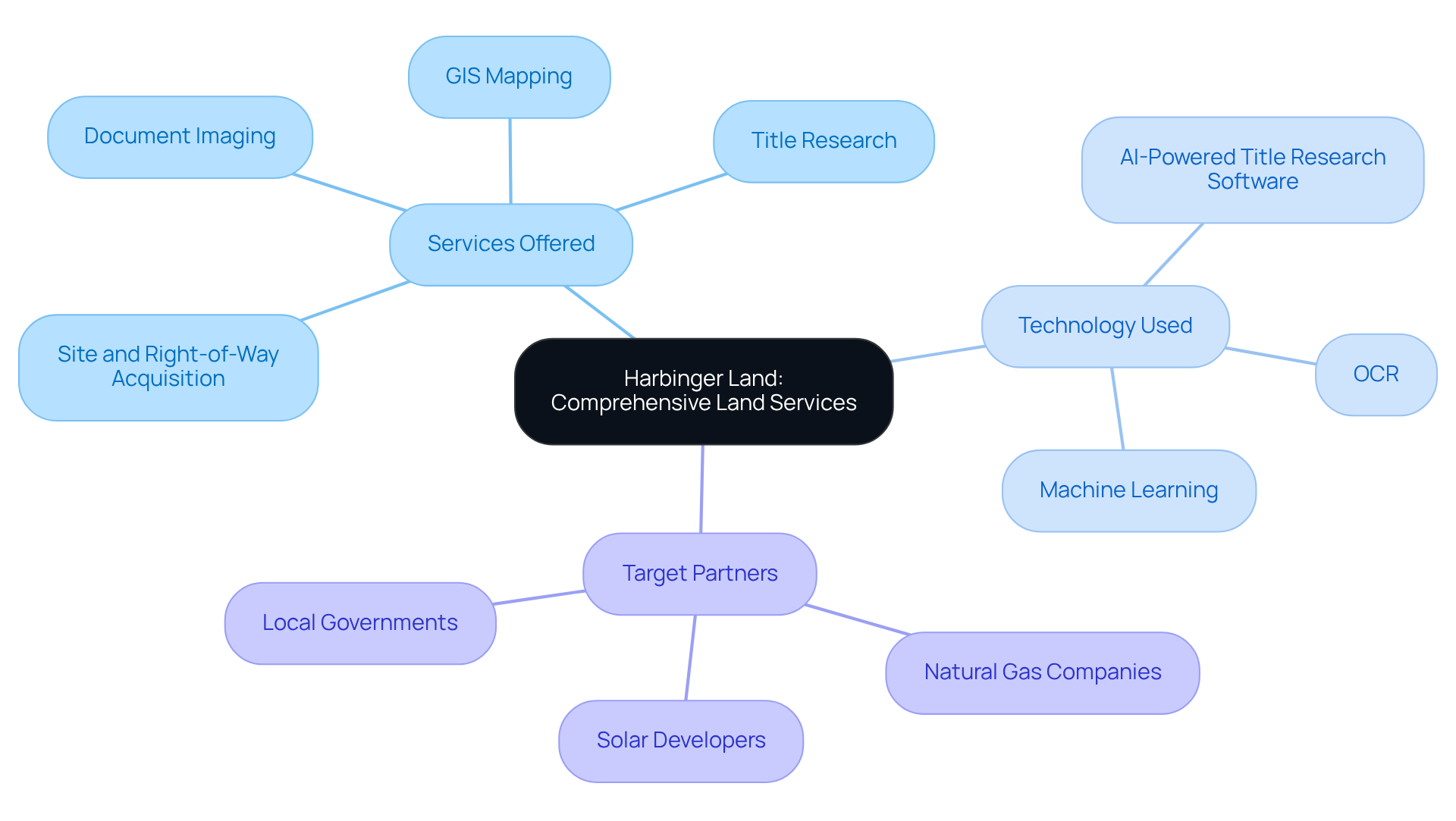
Enhanced Collaboration and Innovation in Hybrid Energy Corridor Development
The cooperation of diverse stakeholders, including government bodies, private enterprises, and local communities, significantly enhances hybrid energy corridor development. This collaboration is essential in addressing the complexities of power infrastructure. By fostering transparent dialogue and aligning on common objectives, stakeholders can devise innovative solutions to intricate challenges.
For instance, the co-location of renewable power facilities not only optimizes land use but also minimizes environmental impacts, showcasing the effectiveness of collaborative efforts in achieving sustainable energy goals.
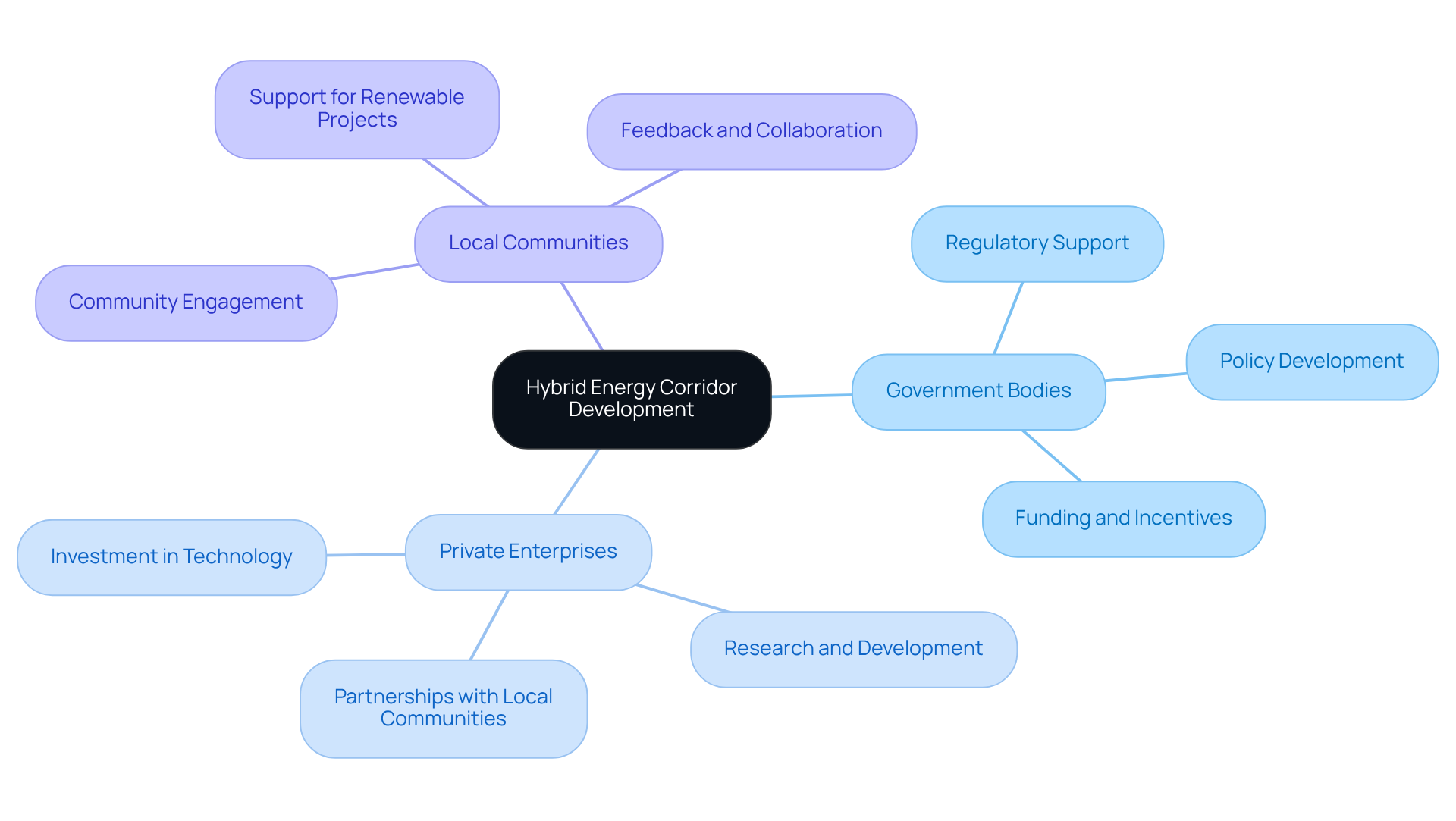
Stronger Team Bonding Through Hybrid Energy Corridor Initiatives
Engaging in combined power pathway initiatives significantly strengthens team connections by fostering cooperation across diverse environments. Team-building activities, whether conducted in-person or virtually, enhance relationships and improve communication among team members. For example, joint workshops and collaborative problem-solving sessions effectively dismantle barriers, leading to a more cohesive team that is well-equipped to tackle the complexities of infrastructure development.
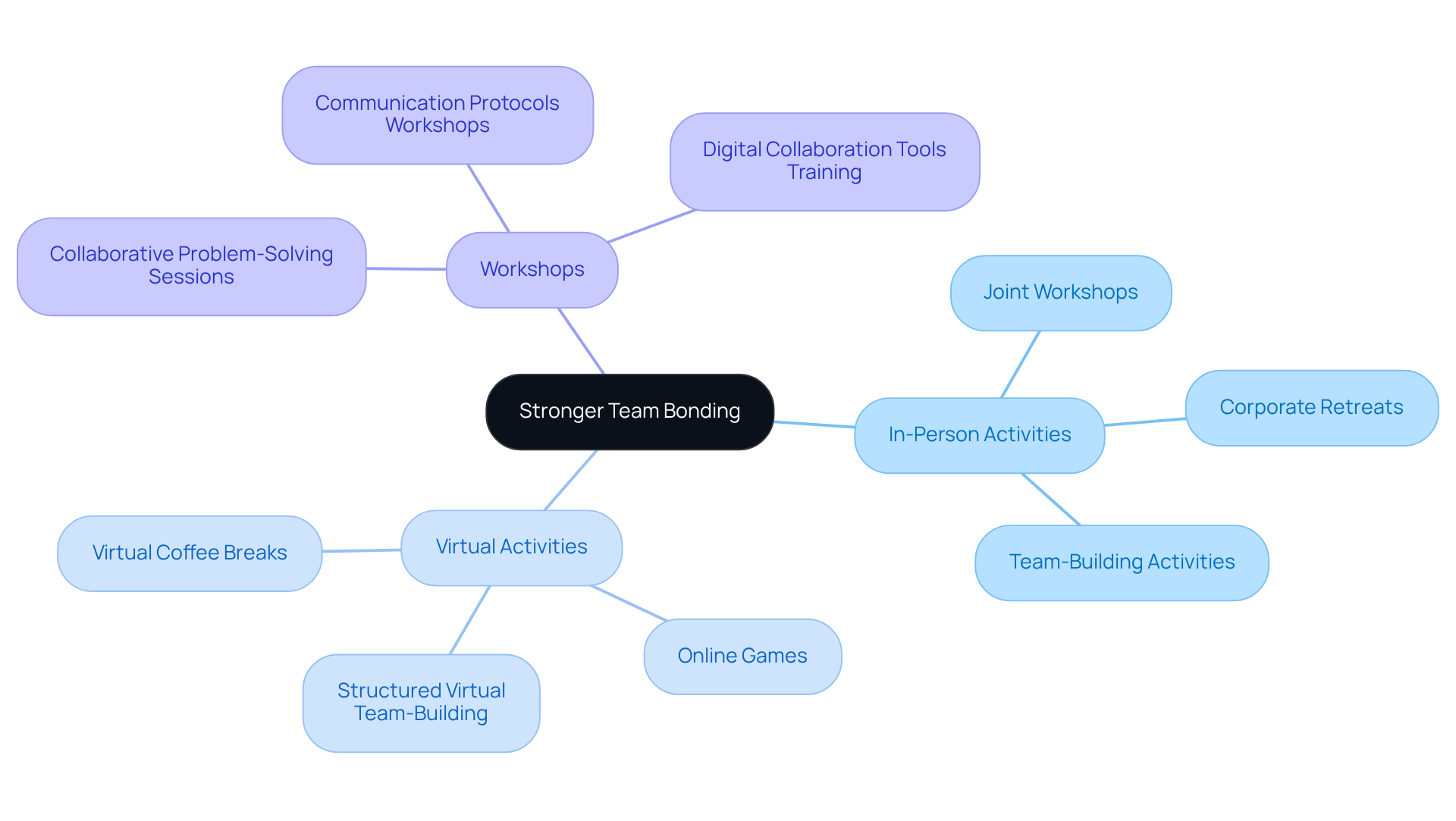
Clearer Boundaries and Work-Life Balance in Hybrid Energy Corridor Projects
In the realm of combined energy corridor initiatives, establishing clear boundaries between professional and personal life is crucial for enhancing productivity and employee well-being. Adaptable employment schedules empower employees to manage their time effectively, resulting in heightened job satisfaction and performance. Notably, studies reveal that:
- 76% of blended workforce members consider improved life balance the foremost advantage of flexible arrangements.
- 68% of staff believe such setups enhance their overall life balance.
By fostering an environment where personnel can set limits on their availability, organizations can cultivate a healthier atmosphere that promotes autonomy and mitigates burnout.
Successful case studies within the power sector illustrate that companies prioritizing employee well-being and hybrid work not only boost satisfaction but also witness significant productivity gains. Employees report being:
- 21% more productive when enjoying improved mental health and reduced stress levels, all stemming from a balanced work-life dynamic.
This strategic approach is essential for attracting and retaining talent in a competitive landscape. Alarmingly,
- 61% of the workforce would reject job offers that disrupt their work-life balance.
- 44% would consider leaving their position if it impeded their ability to enjoy life.
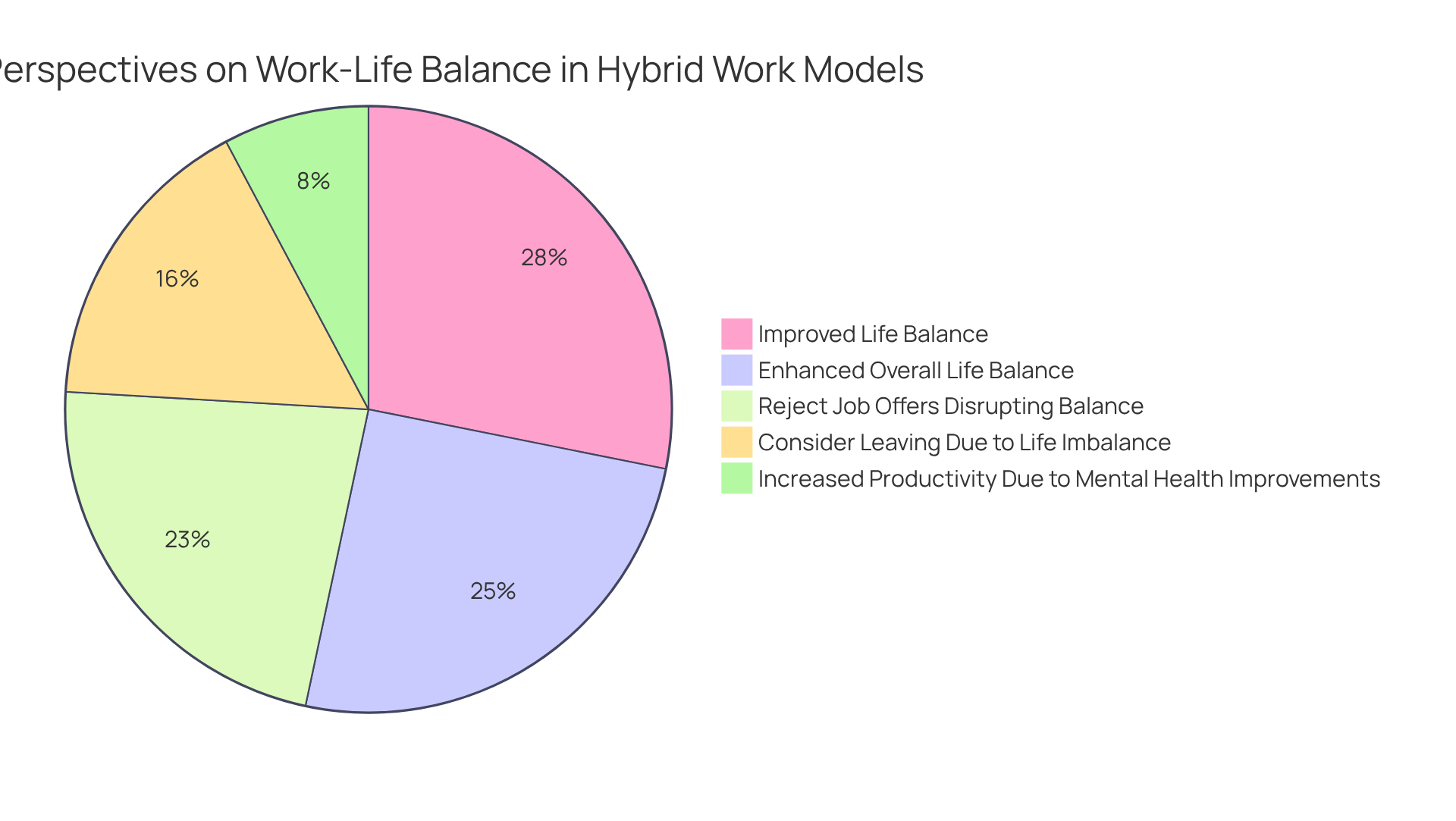
Professional Development and Mentorship Opportunities in Hybrid Energy Corridors
Hybrid power pathway initiatives present significant opportunities for professional growth and guidance within the sector. Engaging in training programs, workshops, and structured mentorship schemes allows professionals to enhance their skills and knowledge substantially.
For instance, organizations can implement mentorship programs that pair seasoned professionals with newcomers, fostering a robust culture of learning and growth. This strategy not only benefits individual career trajectories but also bolsters organizational performance, as employees involved in mentoring programs exhibit a retention rate that is 50% higher than their non-mentored counterparts.
Moreover, companies with structured mentoring programs report profits 18% above the industry average, highlighting the economic advantages of investing in employee development.
Case studies, such as those from Cox Automotive, which achieved a 79% retention rate among mentoring program participants over two years, and a major U.S. academic hospital, which reported an 89% retention rate for mentoring participants, demonstrate that mentorship initiatives can lead to substantial retention improvements.
As the power industry evolves, particularly in response to rapid technological advancements and shifting market demands, prioritizing mentorship is crucial for attracting and retaining talent, ensuring a skilled workforce prepared to meet future challenges.
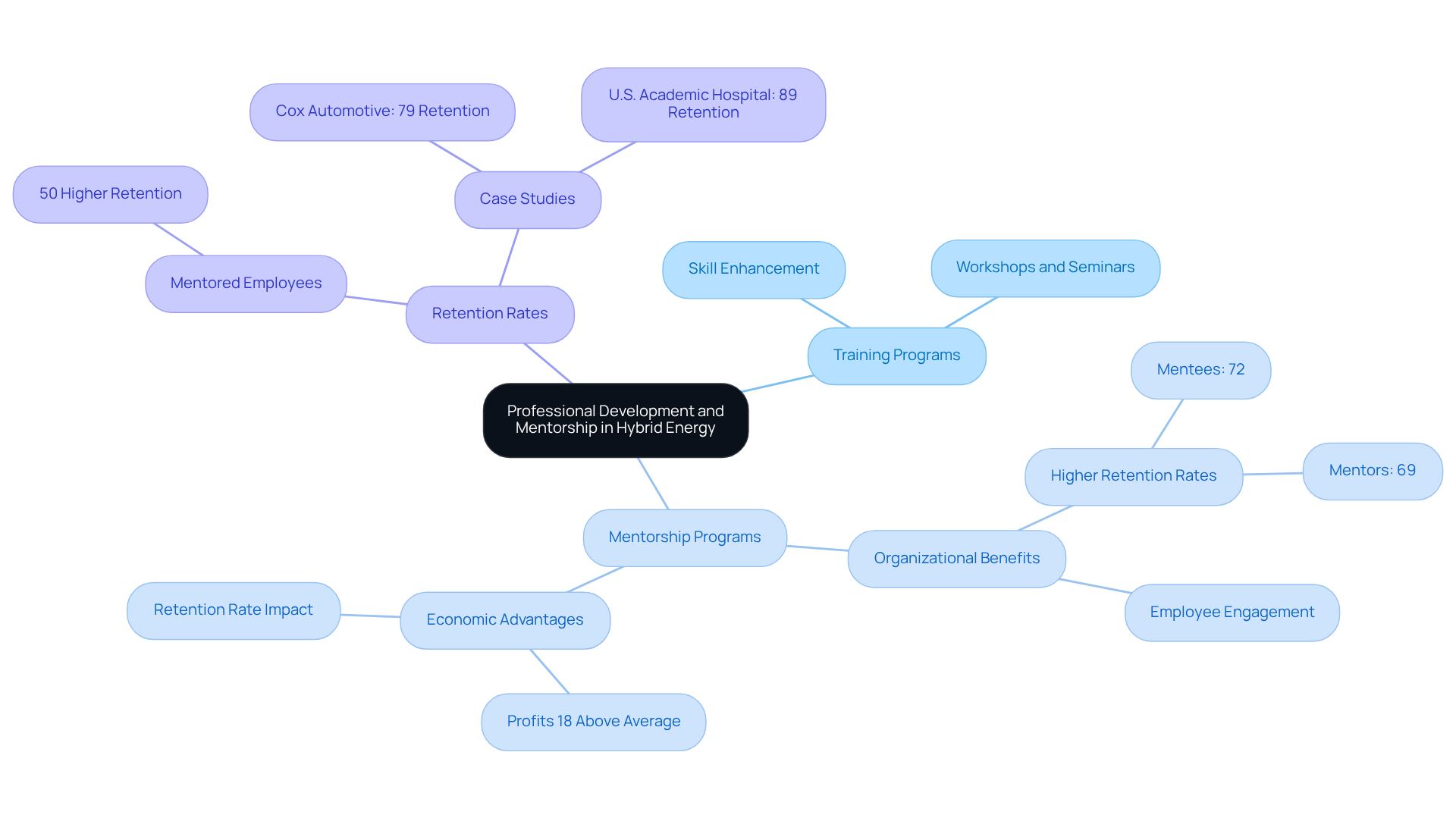
Access to Resources and Support in Hybrid Energy Corridor Development
Successful hybrid energy corridor development hinges on a robust network of resources and support systems, encompassing financial backing, technical expertise, and regulatory guidance. By forging strategic partnerships with local governments, industry associations, and academic institutions, organizations can significantly enhance project outcomes.
Consider the partnership with universities: it not only provides access to advanced research but also fosters innovative technologies pertinent to corridor projects. Such collaborations have demonstrably improved project completion rates and community satisfaction.
For instance, case studies reveal that local ownership resulted in a 92% functionality rate of community-managed solar microgrids after five years, in stark contrast to the mere 65% functionality for externally managed systems.
Additionally, Harbinger Land's expertise in site and right-of-way acquisitions, complemented by advanced GIS modeling services, streamlines the negotiation and acquisition of essential leases and easements for distributed resource (DER) and infrastructure development. This integration of GIS mapping and title research facilitates efficient land rights acquisition, ultimately enhancing decision-making processes while saving clients both time and money.
Furthermore, engaging the community in planning and labor can effectively mitigate delays associated with land disputes or social resistance, ensuring timely project completion. This underscores the critical importance of local involvement and resource mobilization in achieving sustainable power solutions, particularly through hybrid energy corridor development.
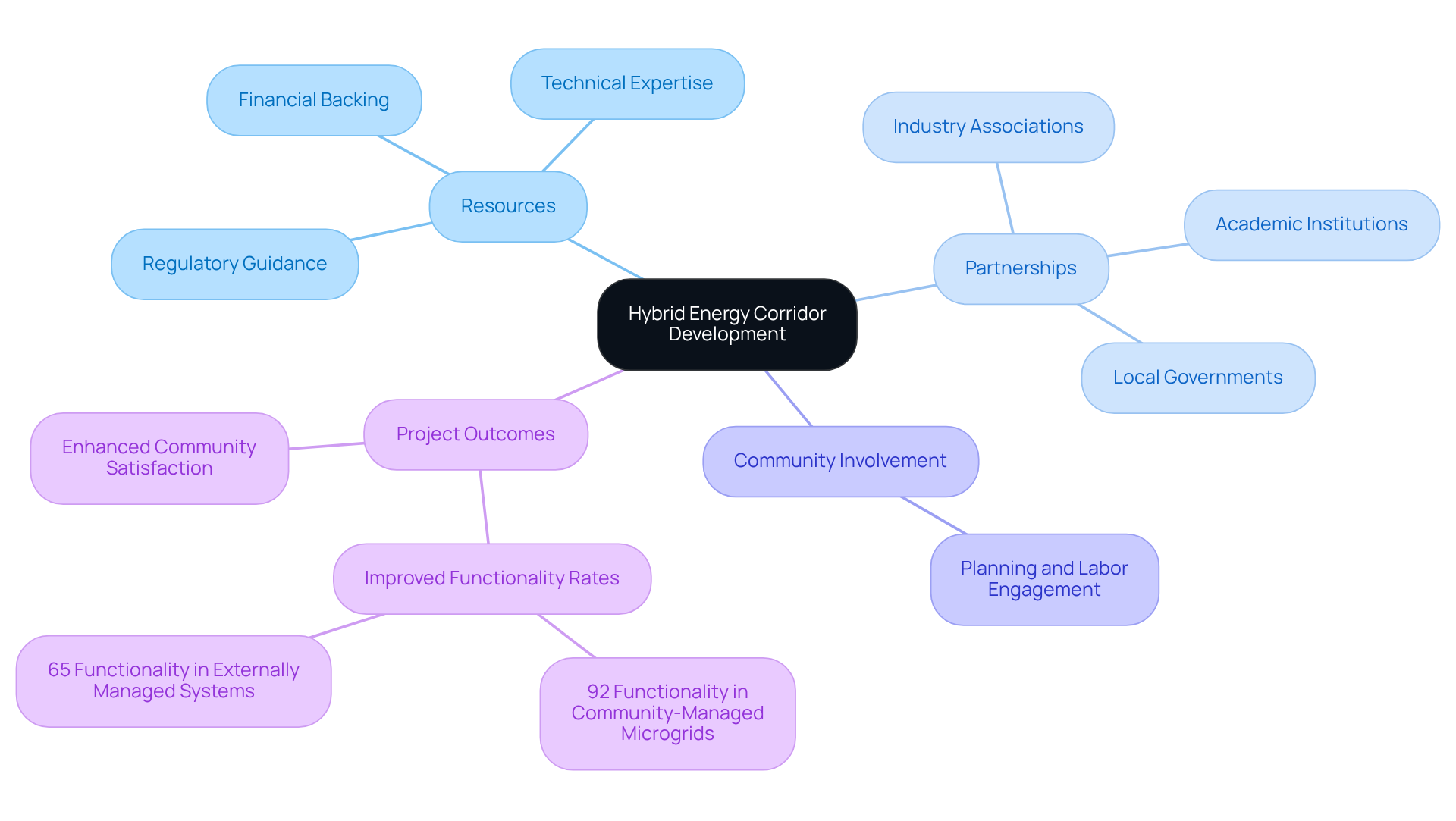
Structured Environment for Focus in Hybrid Energy Corridor Projects
Establishing an organized setting is essential for maintaining concentration and efficiency in mixed power projects. Clear processes, timelines, and responsibilities enable teams to operate with greater efficiency and effectiveness. By utilizing project management tools and methodologies, such as Agile or Lean, organizations can streamline workflows and ensure alignment among all team members with project goals. This structured approach not only enhances productivity but also fosters accountability within teams, creating a robust framework for success.
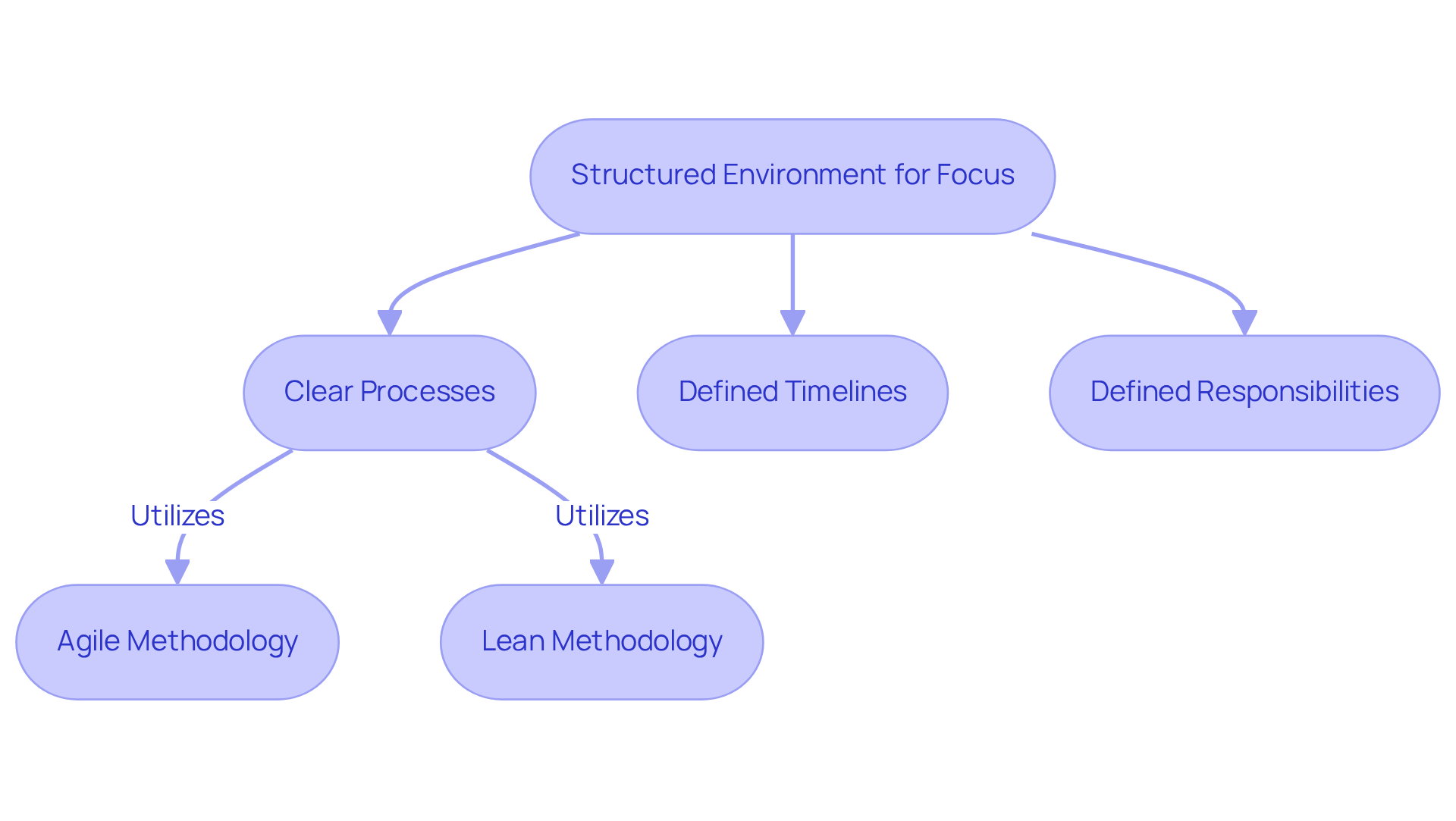
Flexibility Through Hybrid Schedules in Energy Corridor Development
Adopting hybrid schedules in hybrid energy corridor development presents a significant opportunity for flexibility, allowing employees to choose their locations and hours. This adaptability not only enhances job satisfaction but also increases productivity, as individuals can tailor their environments to fit personal preferences and responsibilities.
Consider this: enabling team members to work remotely on designated days helps them balance personal commitments while still contributing to project objectives.
Research indicates that blended job setups can lead to a 22% increase in employee satisfaction, with 83% of staff favoring blended arrangements as their ideal model. Moreover, 88% of organizations observed that their employees maintained or improved productivity while working remotely during the pandemic.
As the energy sector evolves, hybrid energy corridor development becomes essential for embracing adaptable employment models, optimizing project outcomes, and attracting top talent. Notably, 55% of employees prefer to work from home at least three days a week, and 87% desire to work from home at least one day a week, underscoring the demand for flexible work arrangements.
However, it is crucial to effectively manage work-life balance, as 49% of employees report experiencing burnout in hybrid workplaces.
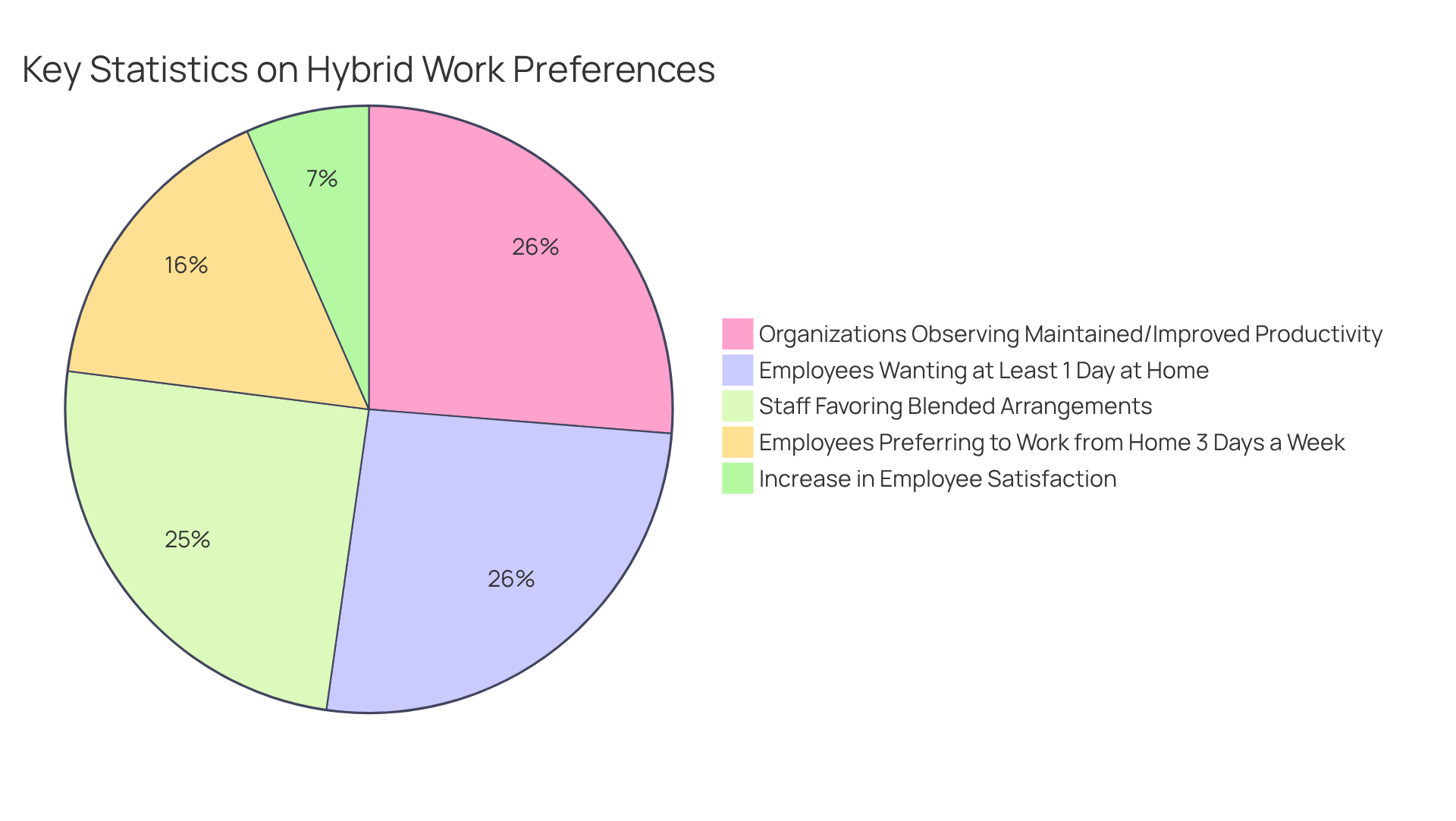
Environmental Benefits of Hybrid Energy Corridor Development
The development of hybrid energy corridors presents significant ecological advantages by promoting the integration of renewable energy sources and reducing reliance on fossil fuels. By strategically locating renewable energy facilities, such as solar and wind, within the same vicinity, developers can minimize land use and habitat disruption. This approach not only conserves resources but also facilitates the efficient transfer of clean energy, contributing to lower greenhouse gas emissions and fostering a more sustainable energy future.
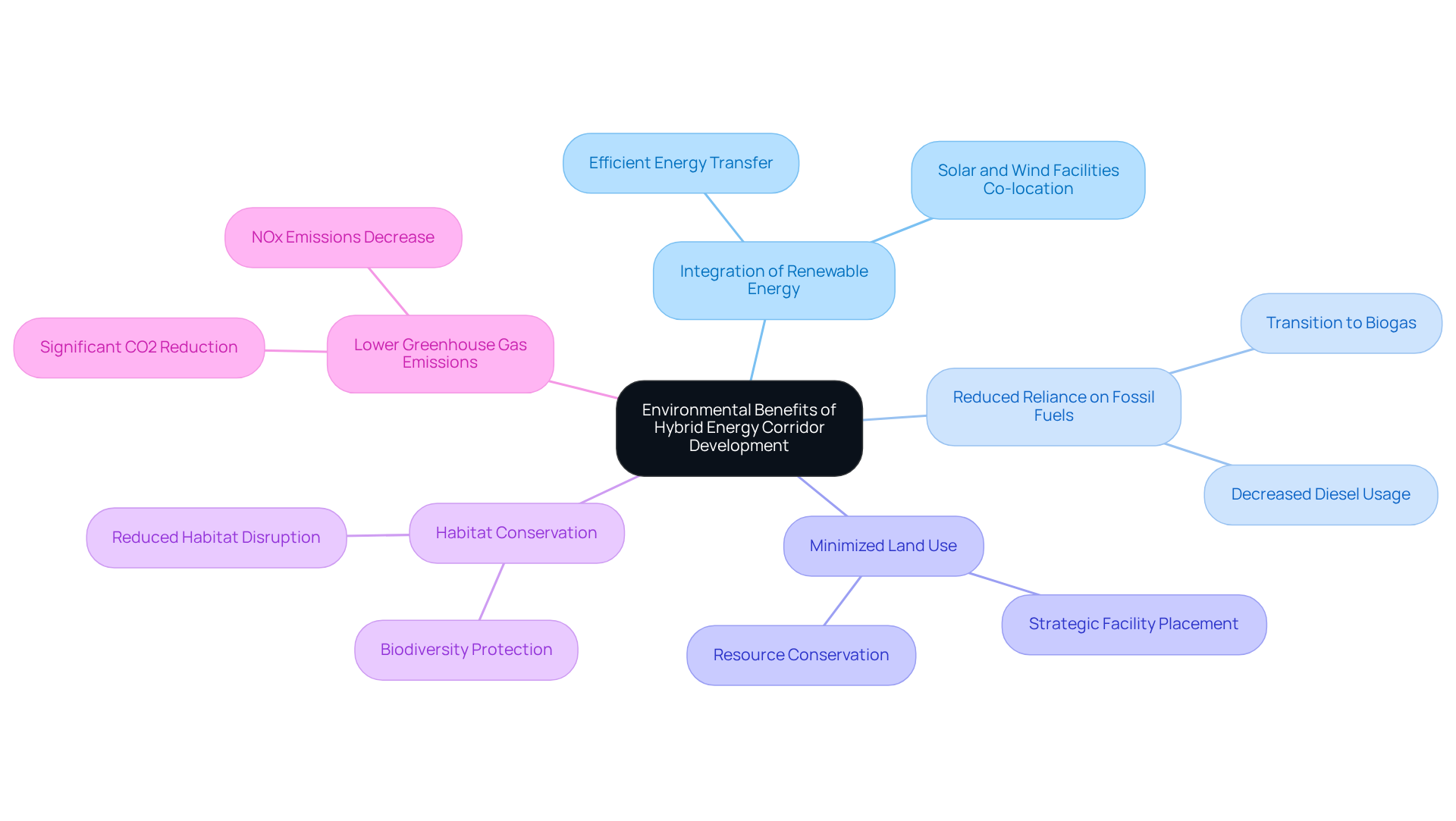
Overall Impact of Hybrid Energy Corridors on Sustainable Growth
The development of hybrid energy corridors is essential for advancing sustainable development in the power sector. These pathways not only facilitate the integration of renewable energy sources but also enhance efficiency, resulting in a more resilient and eco-friendly power infrastructure.
The economic impact is substantial; for instance, the renewable energy sector generated 1.5 million jobs in 2023, with manufacturing contributing over 40% of the total job growth in clean energy fields. Furthermore, combined power pathways attract significant investment in renewable technologies, with production investments surging by 70% to reach $200 billion in 2023. This influx of capital is pivotal in supporting the transition to a low-carbon economy while fostering a diverse range of job opportunities.
Additionally, the overall power sector witnessed a job growth of 3% from 2022 to 2023, reflecting a positive economic landscape for hybrid initiatives. As the energy sector evolves, the hybrid energy corridor development will be essential for driving economic advancement and ensuring a sustainable future.
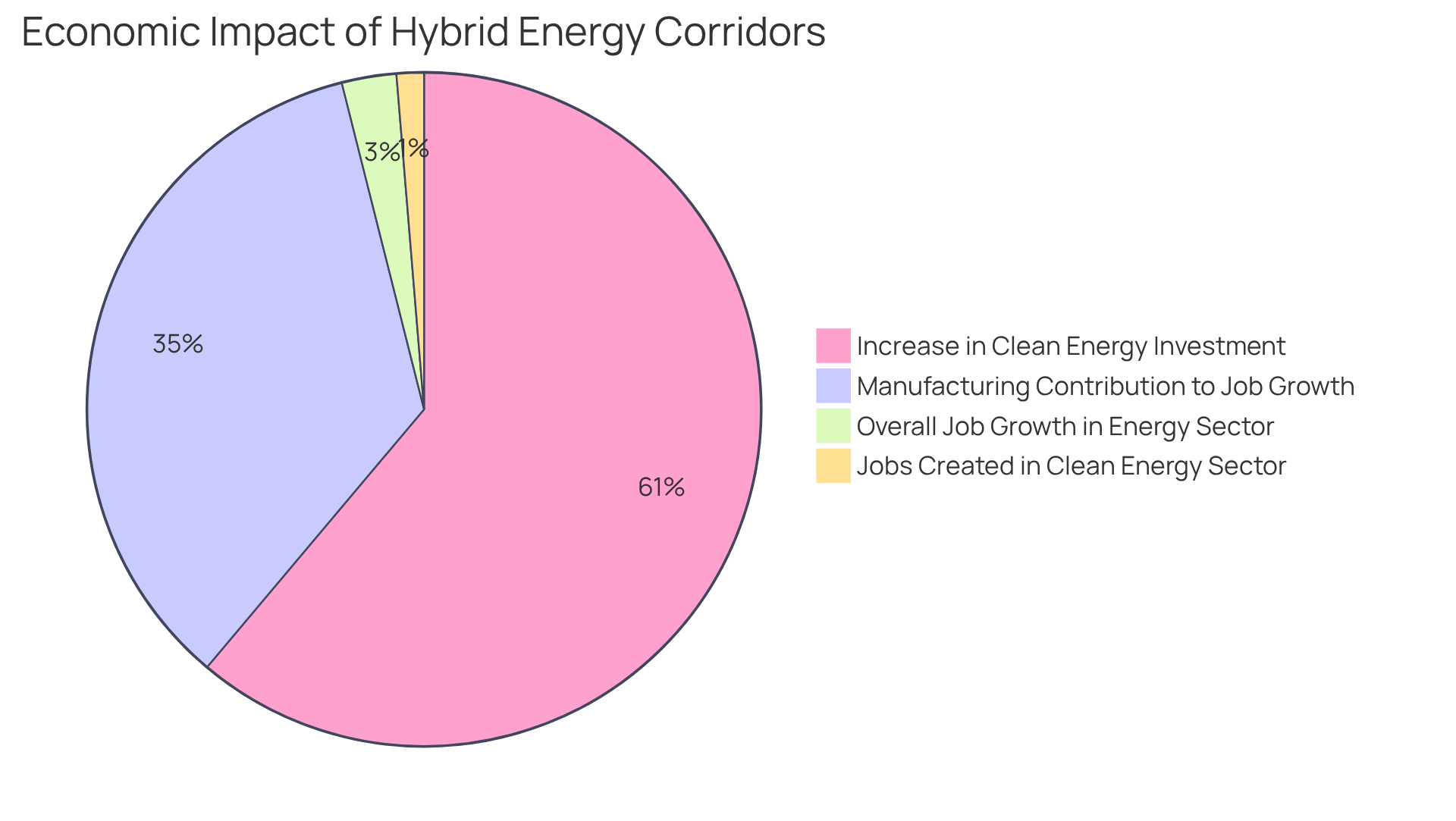
Conclusion
The development of hybrid energy corridors signifies a transformative approach to energy infrastructure, seamlessly integrating renewable resources while enhancing efficiency and sustainability. This initiative addresses the urgent demand for cleaner energy solutions and fosters collaboration among various stakeholders, paving the way for innovative practices and successful project outcomes.
Key insights from the discussion highlight the multifaceted benefits of hybrid energy corridors. These corridors not only strengthen team dynamics through collaborative efforts but also improve work-life balance due to flexible scheduling. Furthermore, they present significant professional development opportunities. The environmental advantages and economic impacts, such as job creation and investment in renewable technologies, underscore the critical role these corridors play in advancing a sustainable energy future.
Ultimately, maintaining a focus on hybrid energy corridor development is essential for cultivating a resilient power sector. Stakeholders are encouraged to embrace these initiatives—not only to capitalize on immediate benefits but also to contribute to the long-term vision of a low-carbon economy. By prioritizing innovation, collaboration, and sustainability, the energy sector can adeptly navigate the complexities of modern energy demands, ensuring a prosperous and environmentally responsible future.
Frequently Asked Questions
What services does Harbinger Land provide?
Harbinger Land offers comprehensive land services for utility and infrastructure projects, including site and right-of-way acquisition, title research, GIS mapping, and document imaging.
How does Harbinger Land enhance operational efficiency?
Harbinger Land enhances operational efficiency by leveraging advanced technology, such as AI-powered title research software and sophisticated data processing through OCR and machine learning.
Who are the primary clients of Harbinger Land?
The primary clients of Harbinger Land include natural gas companies, solar developers, and local governments involved in hybrid energy corridor development.
Why are comprehensive land services important in infrastructure development?
Comprehensive land services are vital in addressing the complexities associated with infrastructure development, especially as the demand for renewable power solutions increases. They help navigate legal and regulatory challenges effectively.
What role does collaboration play in hybrid energy corridor development?
Collaboration among diverse stakeholders, including government bodies, private enterprises, and local communities, enhances hybrid energy corridor development by addressing the complexities of power infrastructure and fostering innovative solutions.
How does co-location of renewable power facilities benefit energy projects?
Co-location of renewable power facilities optimizes land use and minimizes environmental impacts, demonstrating the effectiveness of collaborative efforts in achieving sustainable energy goals.
How do hybrid energy corridor initiatives strengthen team bonding?
Hybrid energy corridor initiatives strengthen team connections by fostering cooperation across diverse environments through team-building activities, which enhance relationships and improve communication among team members.
What types of team-building activities are effective for hybrid energy corridor initiatives?
Effective team-building activities include joint workshops and collaborative problem-solving sessions, which help dismantle barriers and create a more cohesive team ready to tackle infrastructure development challenges.
List of Sources
- Harbinger Land | Comprehensive Solutions for Land Services in Energy and Infrastructure
- How AI Is Transforming the Real Estate Landscape (https://netguru.com/blog/artificial-intelligence-real-estate)
- Ai In Real Estate Market Report Opportunities 2025 Industry Analysis (https://thebusinessresearchcompany.com/report/ai-in-real-estate-global-market-report)
- 10 Real Estate AI Use Cases Transforming the Industry in 2025 (https://softkraft.co/real-estate-ai)
- AI Statistics 2025: Key Trends and Insights Shaping the Future | Vention (https://ventionteams.com/solutions/ai/report)
- 60 Quotes About the Future of Renewable Energy (https://deliberatedirections.com/renewable-energy-quotes)
- Enhanced Collaboration and Innovation in Hybrid Energy Corridor Development
- Discover Renewable Energy Projects Statistics & Examples (https://rib-software.com/en/blogs/renewable-energy-projects)
- Overview and key findings – World Energy Investment 2024 – Analysis - IEA (https://iea.org/reports/world-energy-investment-2024/overview-and-key-findings)
- International Collaboration in Energy Technology (https://oecd.org/en/publications/international-collaboration-in-energy-technology_9789264181298-en.html)
- Energy Sector Collaboration → Term (https://energy.sustainability-directory.com/term/energy-sector-collaboration)
- Sustainable Energy Infrastructure Market Size & Industry Growth 2030 (https://futuredatastats.com/sustainable-energy-infrastructure-market?srsltid=AfmBOoocZuKW64hu-1UflG8nkOOoOFkdwHVTjnYwAwhTseVQG0DDnTVY)
- Stronger Team Bonding Through Hybrid Energy Corridor Initiatives
- 18 Team Building Statistics: How Collaboration Drives Success - Peak Sales Recruiting: The #1 Sales Recruiters (https://peaksalesrecruiting.com/blog/team-building-statistics)
- 12 Team Building Statistics: We surveyed managers and employees (https://teambuildinghub.com/blog/team-building-statistics)
- 18 Essential Team Building Statistics for 2025 (https://teamout.com/blog-post/team-building-statistics)
- Top 50 Team Work Quotes to Boost Collaboration and Drive Success (https://effy.ai/blog/team-work-quotes)
- 130 Team Building Statistics: Culture, Effectiveness, and Tools (https://flair.hr/en/blog/team-building-statistics)
- Clearer Boundaries and Work-Life Balance in Hybrid Energy Corridor Projects
- What % of Employees Prefer Hybrid Work? [Survey Stats] (https://winsavvy.com/what-of-employees-prefer-hybrid-work-survey-stats)
- 35 Work Life Balance Statistics [2025] (https://4dayweek.io/work-life-balance/statistics)
- Employee Wellbeing Hinges on Management, Not Work Mode (https://gallup.com/workplace/648500/employee-wellbeing-hinges-management-not-work-mode.aspx)
- 50+ Essential Hybrid Workplace Statistics to know in 2025 (https://quixy.com/blog/hybrid-workplace-statistics)
- Our Guide to Hybrid Work Statistics – TestGorilla (https://testgorilla.com/blog/hybrid-work-statistics)
- Professional Development and Mentorship Opportunities in Hybrid Energy Corridors
- 31 Mentoring Statistics That Speak for Themselves | Chronus (https://chronus.com/blog/mentoring-statistics)
- Employee Retention and Mentoring (https://mentorcloud.com/employee-retention-and-mentoring)
- Mentoring Statistics in 2024: A Guide to Key Insights and Trends (https://mentoringcomplete.com/mentoring-statistics-everything-you-need-to-know-in-2024)
- 40+ Definitive Mentorship Statistics and Research for 2025 | MentorcliQ (https://mentorcliq.com/blog/mentoring-stats)
- Access to Resources and Support in Hybrid Energy Corridor Development
- What Statistics Indicate the Impact of Local Ownership on Project Success? → Question (https://sustainability-directory.com/question/what-statistics-indicate-the-impact-of-local-ownership-on-project-success)
- A snapshot of the stats from the 2024 Renewable Report — RatedPower (https://ratedpower.com/blog/statistics-renewable-report-2024)
- The Executive Headlines - Top business magazine & news headlines sources (https://executiveheadlines.com/erp/quotes-on-sustainable-energy)
- 20 Quotes To Get You Inspired For a Renewable Future - Solstice (https://solstice.us/solstice-blog/20-quotes-for-a-renewable-future)
- Structured Environment for Focus in Hybrid Energy Corridor Projects
- 41 Productivity Quotes That Will Make You More Effective Dan Silvestre (https://dansilvestre.com/productivity-quotes)
- 102 Productivity Quotes to Supercharge Your Success (https://clockify.me/blog/fun/quotes-about-productivity)
- 31 Must-Know Project Management Statistics in 2025 (https://proofhub.com/articles/project-management-statistics)
- Project Management Statistics By Team Size, Remote Work, Software, Features, Failure and Success (https://electroiq.com/stats/project-management-statistics)
- 50 Inspiring Quotes - Empowering Project Managers with Wisdom (https://linkedin.com/pulse/50-inspiring-quotes-empowering-project-managers-wisdom-ali-mazloum)
- Flexibility Through Hybrid Schedules in Energy Corridor Development
- Unlock the Power of Hybrid Work: 30+ Surprising Statistics That Will Make You Rethink Your Workplace Strategy (https://officernd.com/blog/hybrid-work-statistics)
- Hybrid Work: Impact on Job Satisfaction and Productivity — FLYDESK (https://flydesk.com/insights/hybrid-work-impact-on-job-satisfaction-and-productivity)
- 50+ Essential Hybrid Workplace Statistics to know in 2025 (https://quixy.com/blog/hybrid-workplace-statistics)
- Study finds hybrid work benefits companies and employees (https://news.stanford.edu/stories/2024/06/hybrid-work-is-a-win-win-win-for-companies-workers)
- Indicator: Hybrid Work (https://gallup.com/401384/indicator-hybrid-work.aspx)
- Environmental Benefits of Hybrid Energy Corridor Development
- Techno-economic and environmental analysis of hybrid energy system for industrial sector of Pakistan - Scientific Reports (https://nature.com/articles/s41598-024-74540-z)
- Increasing ecological sustainability using the combinations of technologies to produce power - PMC (https://pmc.ncbi.nlm.nih.gov/articles/PMC10569948)
- Hybrid Power Plants: Status of Operating and Proposed Plants, 2024 Edition | Energy Markets & Policy (https://emp.lbl.gov/publications/hybrid-power-plants-status-2)
- Economic Analysis and Environmental Impacts of a Hybrid PV System in Arid Climate Considering Different Types of Solar Trackers (https://scirp.org/journal/paperinformation?paperid=88128)
- (PDF) Environmental Impact of Solar and Wind energy- A Review (https://researchgate.net/publication/349843737_Environmental_Impact_of_Solar_and_Wind_energy-_A_Review)
- Overall Impact of Hybrid Energy Corridors on Sustainable Growth
- U.S. clean energy jobs by subsector 2024| Statista (https://statista.com/statistics/1499556/us-clean-energy-employment-by-subsector)
- 2024 U.S. Energy & Employment Jobs Report (USEER) (https://energy.gov/policy/us-energy-employment-jobs-report-useer)
- Powering the future: explore the rise of clean energy jobs | Penn LPS Online (https://lpsonline.sas.upenn.edu/features/powering-future-explore-rise-clean-energy-jobs)
- Executive summary – World Energy Employment 2024 – Analysis - IEA (https://iea.org/reports/world-energy-employment-2024/executive-summary)
- Global energy sector employment increased by 3.8% in 2023, outpacing the wider economy - News - IEA (https://iea.org/news/global-energy-sector-employment-increased-by-38-in-2023-outpacing-the-wider-economy)




